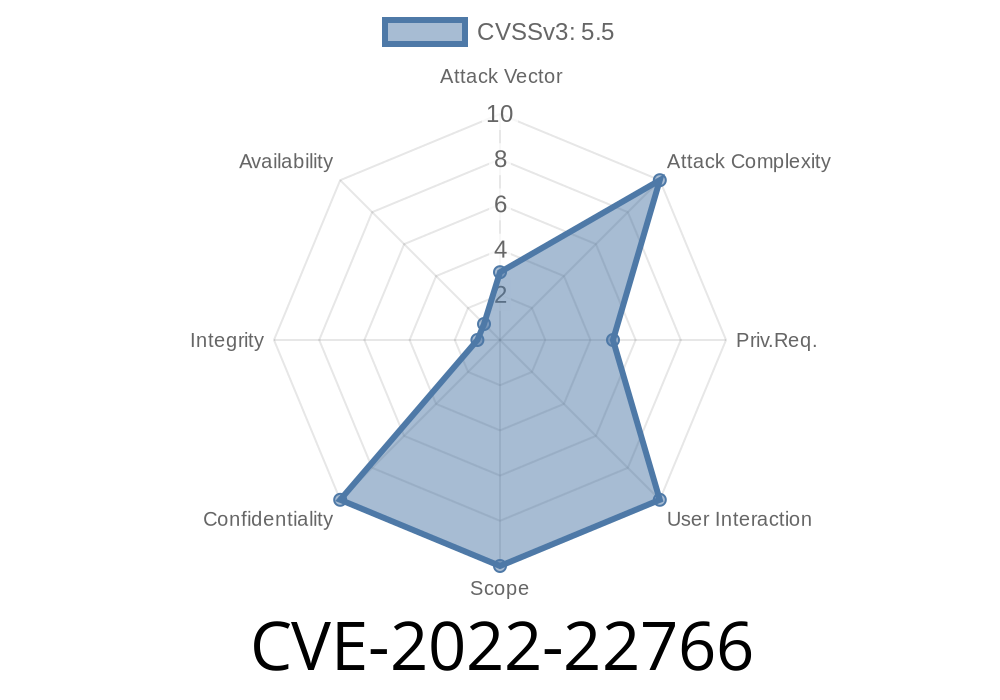A critical security vulnerability (CVE-2022-22766) has been discovered in specific BD Pyxis products, which are widely used healthcare management systems. This issue arises due to the use of hardcoded credentials within the software, potentially allowing threat actors to gain unauthorized access to the underlying file system. If successfully exploited, attackers could leverage this access to decrypt application credentials and expose electronic protected health information (ePHI) or other sensitive data, posing a serious risk to both patients and healthcare providers.
Original References
The vulnerability was initially disclosed by security researchers who have published their findings on these platforms:
1. National Vulnerability Database (NVD): CVE-2022-22766
2. BD Product Security Advisory: BD Pyxis Hardcoded Credentials
Code Snippet
The vulnerability is a result of hardcoded credentials present in the application code, which could potentially be used by an attacker to gain access to the system. A sample code snippet revealing this issue is provided below:
def main():
# Hardcoded credentials (example)
username = 'admin'
password = 'default_password'
# Authentication logic
if authenticate(username, password):
access_protected_resources()
else:
deny_access()
In the code snippet provided, the hardcoded credentials ('admin', 'default_password') would allow an attacker to bypass the authentication check by simply knowing these default values. A secure implementation should avoid the use of hardcoded credentials and rely on proper authentication processes.
Exploit Details
To exploit this vulnerability, an attacker would first need to identify the hardcoded credentials used in a vulnerable installation of BD Pyxis products. This could be achieved in a number of ways, such as analyzing software binaries or gaining access to the source code through unauthorized means.
Once the hardcoded credentials are identified, attackers can use them to gain unauthorized access to the underlying file system. This access would facilitate the exploration of application files containing sensitive information such as ePHI or encryption keys. In the hands of a malicious actor, this data could be used for identity theft, financial fraud, or even to launch further attacks against other systems within the healthcare organization.
Mitigation Strategies
BD has acknowledged this vulnerability and is actively working on a patch to address this issue. In the meantime, healthcare providers using the affected BD Pyxis products should implement the following recommendations:
1. Restrict access to the affected systems by implementing the principle of least privilege. Limit the number of users who have access to these systems and ensure that their permissions are set appropriately.
2. Regularly review access logs to detect any unauthorized access attempts and report any suspicious activity immediately.
3. Ensure robust policies are in place for password management, and avoid using default or easily guessable passwords.
4. Implement network segmentation to prevent unauthorized access to sensitive data, and closely monitor network traffic for potential indicators of compromise.
Conclusion
The hardcoded credentials vulnerability in specific BD Pyxis products (CVE-2022-22766) poses a critical risk to healthcare providers and their patients. To protect sensitive data and maintain the trust of their patients, it is crucial for organizations to take immediate steps to mitigate the potential impact of this vulnerability and stay vigilant about their overall security posture. By following the recommendations outlined above and keeping an eye out for updates from BD, healthcare providers can work towards safeguarding their systems against potential exploitation by threat actors.
Timeline
Published on: 02/11/2022 19:15:00 UTC
Last modified on: 05/11/2022 14:59:00 UTC
